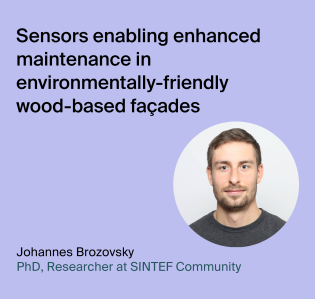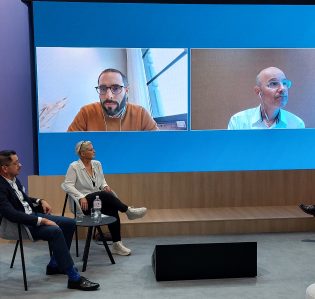Dr. Darius Pupeikis, Dr. Vytautas Bocullo, Justas Kardoka and Dr. Ignacio Vilallon Fornes are specialists from KTU‘s Center for Smart Cities and Infrastructure. In this guest article, they share their insights on the value digital twins bring to façade maintenance by combining monitoring systems, photogrammetry, and BIM models. They also discuss some of the technical challenges they have overcome during this project, including integration of data into the digital twin.
When it comes to building maintenance, people tend to focus on technical issues like pipe blockages and leaks, neglecting the façade, which is the most visible part of the building. The façade is the first line of defence against the harsh conditions outside, such as extreme temperatures, wind, rain, pollution, and more. Proper monitoring and maintenance of the façade is critical in minimising risks and reducing the need for repairs.
Digital twins are a powerful tool for enhancing the way façades are maintained. By combining monitoring systems with building photogrammetry and/or BIM models, a digital twin can be created that provides real-time data on a façade’s critical parameters. This enables maintenance teams to respond proactively, significantly reducing the risk of failure and minimising the need for repairs, thus saving on resources.
Challenges and solutions
While digital twins present an intuitive approach to displaying sensor data, the process of creating them requires the right choice of sensors and sensor location, as well as a good understanding of building physics. This makes it crucial to have a team that includes civil engineers, architects, building physicists, and IT specialists.
Another significant challenge is the integration of different types of data and models into a single system. This includes BIM, GIS, photogrammetry, and sensor data. Finding compatible file formats that contain all the necessary information about the object is also essential. The final product has to make it easy for the maintenance team to interpret the information.
Building a holistic system
The digital twin system we have been developing for this project displays live sensor data in the form of interactive time-series plots that allow the user to view the data categorised by sensor and time frame. Displayed sensors are managed via a panel, grouped into a tree structure. The most significant challenge we faced was linking the live sensor data with the building model, which required us to develop a system to handle and process the data to display it properly.
We initially linked the sensors to their approximate locations in the photogrammetry model, but soon found that such an approach results in a lack of key information, such as the precise sensor element and location, as well as the hosting element’s properties. In light of this, we decided to link the sensors to the BIM model, thereby providing sensor information that is linked to information about the hosting element. The façade’s photogrammetry model was kept in the digital twin to provide a good quality visual representation of the façade, allowing both the BIM and the photogrammetry models to be toggled at any time.
Conclusion
Digital twins have revolutionised the way we monitor and maintain building façades. By combining monitoring systems, photogrammetry, and BIM models, they provide real-time data, enabling maintenance teams to respond proactively. This significantly reduces risk and minimises the need for repairs. However, creating a digital twin requires a team of specialists in civil engineering, architecture, building physics, and IT. Furthermore, the system must be user-friendly and allow for the integration of different types of data and models.
The benefits of digital twins make them an indispensable tool for building maintenance, especially when it comes to façades.
The project “Developing a more environmentally-friendly automated façade system that is integrated into the building’s control systems” is funded by the 2014-2021 Norwegian Financial Mechanism programme “Business Development, Innovation, and SMEs” as well as by EEA and Norway Grants.
About the authors:
Dr. Darius Pupeikis, Head of the CSCI, is project coordinator for the KTU team, offering a strategic overview of digital twins in the context of smart cities. Darius is a civil engineer who specialises in BIM, building data science, and energy performance.
Dr. Vytautas Bocullo is coordinating activities related to reality-capture and analysis of façade digital representation technologies. Vytautas is a civil engineer with a specialisation in digital twins, reality-capture technologies (photogrammetry, lidar) and construction materials.
Justas Kardoka has a background in IT and software development, and is primarily involved in activities related to the integration of IoT and digital geometrical representation data sources and formats.
Completing the CSCI team is Dr. Ignacio Vilallon Fornes, who is working on the digitalisation of façade structures and components. As a structural engineer, Ignacio helps the CSCI team with BIM modelling and provides building physics advice relevant to façades.







